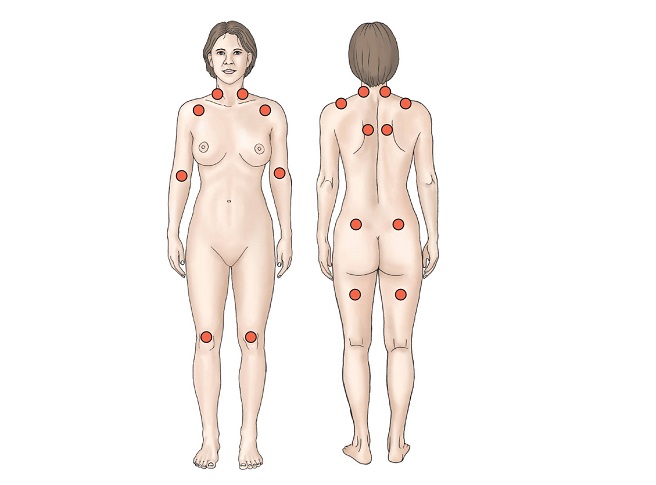Fibromyalgia, also known as fibromyalgia syndrome , is a chronic condition that characteristically causes pain throughout the body, including muscle and joint pain, fatigue, and digestive problems, being just a few signs of fibromyalgia , but including others as well, such as depression and social isolation.

Fibromyalgia is a particularly distressing condition, which can affect someone both mentally and physically. Upon waking, someone with fibromyalgia commonly experiences a rapid onset of fatigue when trying to move their body.
The severe mental and physical complications of fibromyalgia can make the daily grind difficult to navigate. Before we delve into the signs of fibromyalgia , here are some relevant facts about the condition:
- Women ages 25 to 60 make up the majority of fibromyalgia patients.
- Women are 10 times more likely to develop the disease.
- The diagnosis of fibromyalgia requires a complete physical examination, as a doctor must rule out any other similar conditions/s.
- A blood test, specifically a complete blood count (FBC) and thyroid exam, is routinely done to diagnose the condition.
- Following a diagnosis of fibromyalgia, patients are often referred to a rheumatologist for appropriate treatment.
Ways you may be showing signs of fibromyalgia
We hope that this article will help those who may be affected by fibromyalgia to seek medical advice.
1. Pains from the head to the feet
Most who visit the doctor – and are ultimately diagnosed with fibromyalgia – complain of proliferating body pain. About 97 percent of people with fibromyalgia experience pain throughout their body.
Fibromyalgia pain is often described as “deep, sharp, and throbbing,” and can affect ligaments, muscles, and tendons. The pain associated with fibromyalgia is often consistent and does not respond to over-the-counter pain medications.
2. Persistent fatigue or exhaustion
Fatigue is the second most common complaint of people diagnosed with this condition. It is one of the easiest signs of fibromyalgia to detect. The main difference between someone experiencing “tiredness” and extreme fatigue (ie exhaustion) is the duration of the associated symptoms.

Those with fibromyalgia often associate their feeling of fatigue as being affected by the flu. They are simply unable to move at a normal level. This feeling of exhaustion applies to simple tasks, exercise, and even waking up.
3. Body stiffness
More than 75 percent of those with the condition experience body stiffness, particularly during the morning hours. This physical sense of stiffness is similar to those diagnosed with arthritis, especially inflammatory or rheumatoid arthritis.
In some cases, these symptoms go away in 10 to 15 minutes; In others, they will last most of the day, if not all waking hours.
4. Poor quality sleep
Due to their physical and mental states, those with fibromyalgia find it difficult to get quality sleep. One reason for this is the erratic brain activity experienced in fibromyalgia patients during rest. This discomfort when falling asleep, is followed by interruptions caused by irregular brain activity.
6. Abnormal digestion
Constipation, diarrhea, and bloating are potential symptoms of fibromyalgia. Approximately 40 to 70 percent of patients experience symptoms similar to Irritable Bowel Syndrome , or IBS. Acid reflux and Gastroesophageal Reflux Disease (GERD) are reported at a similar rate.
7. Numbness, swelling and tingling
About half of people with fibromyalgia experience a “pins and needles” sensation in their arms, feet, hands, and legs, a condition known as paresthesia . For some, these sensations may last no more than a few minutes; for others, they can be quite consistent.
Similar to many symptoms related to fibromyalgia, paresthesia is often barely noticeable. It is important, however, for those who experience frequent numbness, swelling, and tingling in the arms, feet, hands, or legs to seek medical advice.
5. “Trigger points” that evoke pain or tenderness
Similar to arthritis patients, those with fibromyalgia often have “trigger points,” or areas of the body that produce painful sensations disproportionately often.
Unfortunately, when pressure is applied, these “trigger points” are extremely painful. Fortunately, when fibromyalgia is diagnosed, a specialist can provide valuable information about its management.

8. Spasms of fingers and toes
Arterial spasms of the hands or toes are said to be present in 25 to 50 percent of fibromyalgia patients. This symptom occurs as a result of exposure to cold or stress.
Importantly, the affected areas often have a bluish or pale coloration and are also accompanied by pain. Known as Raynaud’s syndrome, or Raynaud’s phenomenon, the aforementioned symptoms often dissipate when heat is applied.
9. Sensitivity to temperature
Due to their bodily condition, it is very difficult for those with fibromyalgia to regulate their body temperature. As you’ve probably already noticed, some of the aforementioned symptoms are surprisingly similar to arthritis.
It is common for temperature fluctuations to be unwelcome by people with fibromyalgia. Sometimes afflicted patients complain that the environment is too hot or cold for them – a symptom that makes it difficult for them to be productive or rest adequately.
10. “Foggy Fiber”
Similar to “brain fog”, one of the signs of fibromyalgia also very common, it can manifest as concentration problems. Additionally, people with this condition may experience short-term memory difficulties. They may also have general feelings of confusion, forgetfulness, and lack of mental clarity.
Without proper medical intervention, “fibro-fog” can negatively affect everyday life. This is particularly evident during work or personal time.


